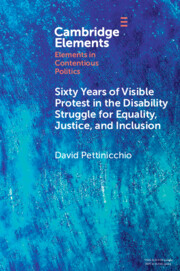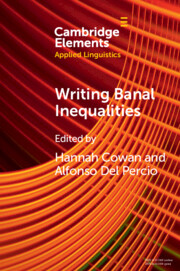39 results
From intention to action – cultivating future-ready One Health agents of change
-
- Journal:
- Research Directions: One Health / Volume 2 / 2024
- Published online by Cambridge University Press:
- 25 March 2024, e8
-
- Article
-
- You have access
- Open access
- HTML
- Export citation

Sixty Years of Visible Protest in the Disability Struggle for Equality, Justice, and Inclusion
-
- Published online:
- 16 March 2024
- Print publication:
- 11 April 2024
-
- Element
- Export citation
The Ageing Self through Dramaturgies of Memory Loss and Love: Tristan Bernays’ Old Fools and Nick Payne’s Elegy
-
- Journal:
- New Theatre Quarterly / Volume 40 / Issue 1 / February 2024
- Published online by Cambridge University Press:
- 13 February 2024, pp. 76-87
- Print publication:
- February 2024
-
- Article
- Export citation
17 - Planetary Health
- from Part 2 - Contexts for Public Health Practice
-
-
- Book:
- Essential Public Health
- Published online:
- 01 December 2023
- Print publication:
- 14 December 2023, pp 323-338
-
- Chapter
- Export citation
6 - The Multiversity
- from Part II - A History of the Future
-
- Book:
- City of Intellect
- Published online:
- 27 October 2023
- Print publication:
- 16 November 2023, pp 253-277
-
- Chapter
- Export citation
Disruption as an opportunity or threat: A qualitative analysis of factors influencing the attitudes of experts in serious illness care toward psychedelic-assisted therapies
-
- Journal:
- Palliative & Supportive Care / Volume 21 / Issue 6 / December 2023
- Published online by Cambridge University Press:
- 11 October 2023, pp. 967-972
-
- Article
- Export citation

Business Model Innovation
- Strategic and Organizational Issues for Established Firms
-
- Published online:
- 31 May 2023
- Print publication:
- 29 June 2023
-
- Element
- Export citation

Writing Banal Inequalities
- How to Fabricate Stories Which Disrupt
-
- Published online:
- 26 May 2023
- Print publication:
- 22 June 2023
-
- Element
- Export citation
Receding resilience: On the planetary moods of disruption
-
- Journal:
- Review of International Studies / Volume 49 / Issue 1 / January 2023
- Published online by Cambridge University Press:
- 09 November 2022, pp. 3-19
- Print publication:
- January 2023
-
- Article
- Export citation
Disruption from above, the middle and below: Three terrains of governance
-
- Journal:
- Review of International Studies / Volume 49 / Issue 1 / January 2023
- Published online by Cambridge University Press:
- 21 October 2022, pp. 37-52
- Print publication:
- January 2023
-
- Article
-
- You have access
- Open access
- HTML
- Export citation
1 - Artificial Intelligence
- from Part I - AI: Development and Trends
-
-
- Book:
- The Cambridge Handbook of Artificial Intelligence
- Published online:
- 28 July 2022
- Print publication:
- 11 August 2022, pp 3-17
-
- Chapter
-
- You have access
- HTML
- Export citation
Chapter 29 - The AI Economy and Higher Education
- from Part VII - Futuristic and Ultramodern Higher Education
-
-
- Book:
- Digital Transformation and Disruption of Higher Education
- Published online:
- 09 June 2022
- Print publication:
- 23 June 2022, pp 391-404
-
- Chapter
- Export citation
2 - Disruptive Effects of Legal Tech
- from Part I - Effects of Technology on Legal Practice
-
-
- Book:
- The Cambridge Handbook of Lawyering in the Digital Age
- Published online:
- 18 November 2021
- Print publication:
- 25 November 2021, pp 9-37
-
- Chapter
- Export citation
16 - Industry and Manufacturing
- from Cities and Industry
-
-
- Book:
- Transitioning to a Prosperous, Resilient and Carbon-Free Economy
- Published online:
- 08 October 2021
- Print publication:
- 28 October 2021, pp 408-438
-
- Chapter
- Export citation
2 - Trade Law in a Data-Driven Economy
- from Part I - Systemic Shifts in the Global Economic Order
-
-
- Book:
- Artificial Intelligence and International Economic Law
- Published online:
- 01 October 2021
- Print publication:
- 14 October 2021, pp 29-53
-
- Chapter
-
- You have access
- Open access
- HTML
- Export citation
1 - Artificial Intelligence and International Economic Law
-
-
- Book:
- Artificial Intelligence and International Economic Law
- Published online:
- 01 October 2021
- Print publication:
- 14 October 2021, pp 1-26
-
- Chapter
-
- You have access
- Open access
- HTML
- Export citation
10 - Beyond Enthronement
- from Part V - Inauguration
-
- Book:
- Paths to Kingship in Medieval Latin Europe, c. 950–1200
- Published online:
- 24 September 2021
- Print publication:
- 14 October 2021, pp 351-398
-
- Chapter
- Export citation
1 - Introduction
-
- Book:
- Disrupting Africa
- Published online:
- 19 July 2021
- Print publication:
- 29 July 2021, pp 1-8
-
- Chapter
- Export citation
2 - International Rules for War Zones
- from Part I - International Rules for War Economies
-
- Book:
- War Economies and International Law
- Published online:
- 24 June 2021
- Print publication:
- 15 July 2021, pp 48-82
-
- Chapter
- Export citation
3 - The Context for a New Purpose
-
- Book:
- Thrive
- Published online:
- 21 January 2021
- Print publication:
- 18 February 2021, pp 24-37
-
- Chapter
- Export citation



